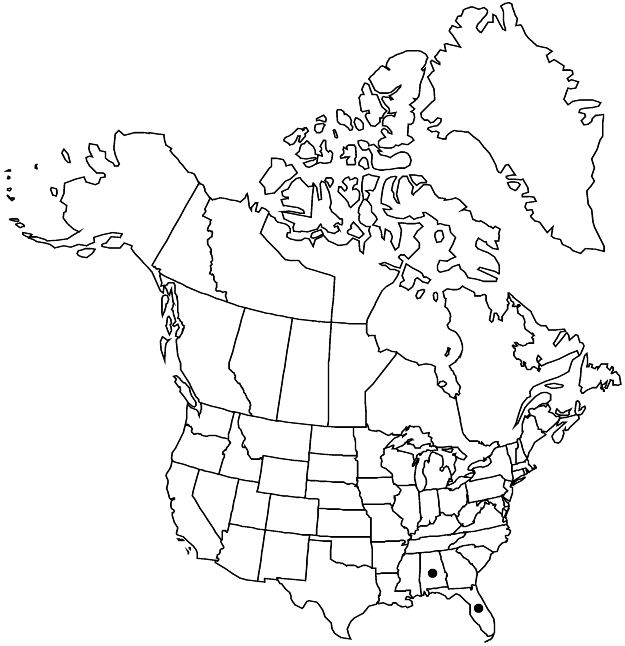Difference between revisions of "Malvastrum corchorifolium"
Fl. Miami, 200. 1913.
FNA>Volume Importer |
FNA>Volume Importer |
||
| Line 30: | Line 30: | ||
|elevation=0–20 m | |elevation=0–20 m | ||
|distribution=Ala.;Fla.;Mexico;West Indies;Central America;introduced in Africa (Ghana). | |distribution=Ala.;Fla.;Mexico;West Indies;Central America;introduced in Africa (Ghana). | ||
| − | |discussion=<p>Malvastrum corchorifolium is most likely a stabilized allopolyploid hybrid between M. americanum and M. coromandelianum, and it appears to have originated and stabilized at least twice, in eastern Central America (Honduras or Nicaragua) and somewhere in the West Indies (the two groups are morphologically distinguishable). Plants in the flora area have typical West Indian morphology, as do those from Ghana, the latter possibly introduced during the time of the slave trade. The Alabama record was historic only; the specimen was collected on ship ballast brought in from Jamaica.</p> | + | |discussion=<p><i>Malvastrum corchorifolium</i> is most likely a stabilized allopolyploid hybrid between <i>M. americanum</i> and <i>M. coromandelianum</i>, and it appears to have originated and stabilized at least twice, in eastern Central America (Honduras or Nicaragua) and somewhere in the West Indies (the two groups are morphologically distinguishable). Plants in the flora area have typical West Indian morphology, as do those from Ghana, the latter possibly introduced during the time of the slave trade. The Alabama record was historic only; the specimen was collected on ship ballast brought in from Jamaica.</p> |
|tables= | |tables= | ||
|references= | |references= | ||
| Line 54: | Line 54: | ||
|publication year=1913 | |publication year=1913 | ||
|special status= | |special status= | ||
| − | |source xml=https://jpend@bitbucket.org/aafc-mbb/fna-data-curation.git/src/ | + | |source xml=https://jpend@bitbucket.org/aafc-mbb/fna-data-curation.git/src/8f726806613d60c220dc4493de13607dd3150896/coarse_grained_fna_xml/V6/V6_538.xml |
|subfamily=Malvaceae subfam. Malvoideae | |subfamily=Malvaceae subfam. Malvoideae | ||
|genus=Malvastrum | |genus=Malvastrum | ||
Revision as of 17:48, 18 September 2019
Herbs, annual or perennial, suffruticose in age, 0.6–1.5 m, sparsely branched in proximal 1/2, usually with 1 main stem. Stems erect, hairs scattered, appressed, distinctly bilateral, 4-rayed, not sublepidote, swollen-based, or few, minute, marginal, simple hairs. Inflorescences axillary, solitary flowers at first, later congested or loose terminal spikes 1–2 cm, these in distal leaf axils or terminating each branch; floral bracts usually 2-fid, 3–6 × 1 mm, or flowers subtended by leaf and stipules. Pedicels 0.5–2 mm; involucellar bractlets basally adnate to calyx for 0.5–1 mm, lanceolate, subfalcate, 4–6 × 0.8–1 mm, ± equaling calyx lobes, apex acuminate. Flowers: calyx connate for 1/4–1/3 its length, broadly campanulate, 5–6 mm, to 7–11 mm in fruit, surface moderately hairy, hairs simple, 2–4-rayed, mixed with scattered, 4–6-rayed, stellate, minute hairs; corolla campanulate to wide-spreading, yellow to pale yellow-orange, 12–17 mm diam., petals obovate, asymmetrically lobed, 6–7 × 3–4 mm, exceeding calyx by 2 mm; staminal column 2–2.5 mm, sparsely stellate-puberulent; style (9–)11–13(–16)-branched. Schizocarps 4–7 mm diam.; mericarps tardily shed from calyx, (9–)11–13(–16), 2.5–3 × 2–2.5 × 1.1 mm, margins angled, sides radially ribbed, narrowly-notched, with 3 minute, apical cusps 0.1–0.4 mm, 1 at proximal-apical surface, 2 at distal-apical surface, moderately hairy on dorsal 1/3, hairs erect, minute, simple or 2–rayed, and erect, simple, rigid hairs 0.5–1 mm, minutely hirsute with ascending, simple hairs 0.1–0.5 mm mixed with minute, simple or 2- or 3-rayed, stellate hairs. Seeds 1.5–1.7 mm. 2n = 48.
Phenology: Flowering nearly year-round when sufficiently wet and warm.
Habitat: Open, usually coastal, calcareous soil
Elevation: 0–20 m
Distribution

Ala., Fla., Mexico, West Indies, Central America, introduced in Africa (Ghana).
Discussion
Malvastrum corchorifolium is most likely a stabilized allopolyploid hybrid between M. americanum and M. coromandelianum, and it appears to have originated and stabilized at least twice, in eastern Central America (Honduras or Nicaragua) and somewhere in the West Indies (the two groups are morphologically distinguishable). Plants in the flora area have typical West Indian morphology, as do those from Ghana, the latter possibly introduced during the time of the slave trade. The Alabama record was historic only; the specimen was collected on ship ballast brought in from Jamaica.
Selected References
None.